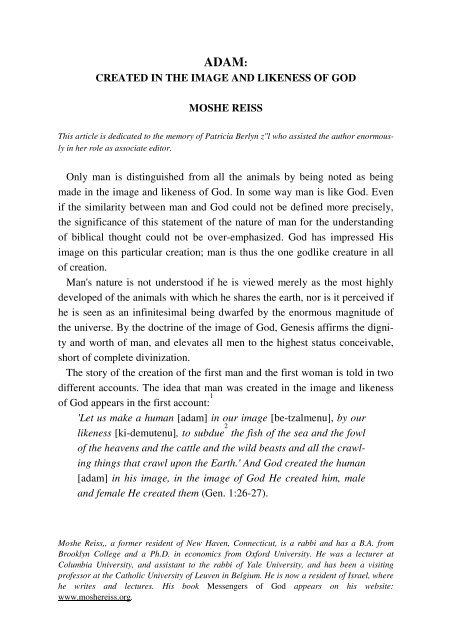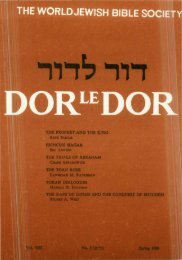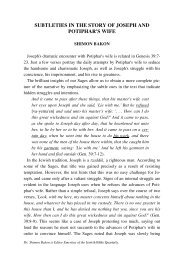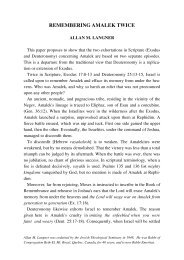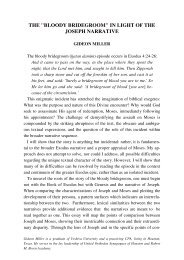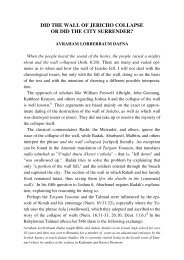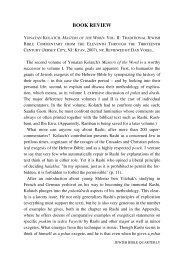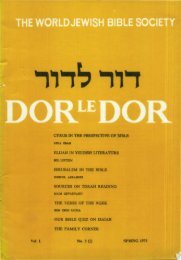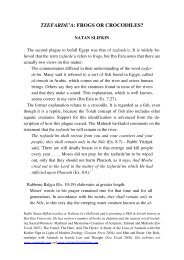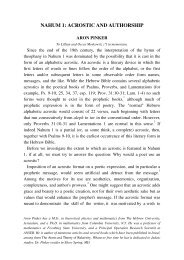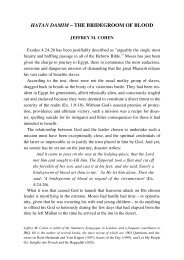Adam: Created in the Image and Likeness of God - Jewish Bible ...
Adam: Created in the Image and Likeness of God - Jewish Bible ...
Adam: Created in the Image and Likeness of God - Jewish Bible ...
You also want an ePaper? Increase the reach of your titles
YUMPU automatically turns print PDFs into web optimized ePapers that Google loves.
ADAM:<br />
CREATED IN THE IMAGE AND LIKENESS OF GOD<br />
MOSHE REISS<br />
This article is dedicated to <strong>the</strong> memory <strong>of</strong> Patricia Berlyn z"l who assisted <strong>the</strong> author enormously<br />
<strong>in</strong> her role as associate editor.<br />
Only man is dist<strong>in</strong>guished from all <strong>the</strong> animals by be<strong>in</strong>g noted as be<strong>in</strong>g<br />
made <strong>in</strong> <strong>the</strong> image <strong>and</strong> likeness <strong>of</strong> <strong>God</strong>. In some way man is like <strong>God</strong>. Even<br />
if <strong>the</strong> similarity between man <strong>and</strong> <strong>God</strong> could not be def<strong>in</strong>ed more precisely,<br />
<strong>the</strong> significance <strong>of</strong> this statement <strong>of</strong> <strong>the</strong> nature <strong>of</strong> man for <strong>the</strong> underst<strong>and</strong><strong>in</strong>g<br />
<strong>of</strong> biblical thought could not be over-emphasized. <strong>God</strong> has impressed His<br />
image on this particular creation; man is thus <strong>the</strong> one godlike creature <strong>in</strong> all<br />
<strong>of</strong> creation.<br />
Man's nature is not understood if he is viewed merely as <strong>the</strong> most highly<br />
developed <strong>of</strong> <strong>the</strong> animals with which he shares <strong>the</strong> earth, nor is it perceived if<br />
he is seen as an <strong>in</strong>f<strong>in</strong>itesimal be<strong>in</strong>g dwarfed by <strong>the</strong> enormous magnitude <strong>of</strong><br />
<strong>the</strong> universe. By <strong>the</strong> doctr<strong>in</strong>e <strong>of</strong> <strong>the</strong> image <strong>of</strong> <strong>God</strong>, Genesis affirms <strong>the</strong> dignity<br />
<strong>and</strong> worth <strong>of</strong> man, <strong>and</strong> elevates all men to <strong>the</strong> highest status conceivable,<br />
short <strong>of</strong> complete div<strong>in</strong>ization.<br />
The story <strong>of</strong> <strong>the</strong> creation <strong>of</strong> <strong>the</strong> first man <strong>and</strong> <strong>the</strong> first woman is told <strong>in</strong> two<br />
different accounts. The idea that man was created <strong>in</strong> <strong>the</strong> image <strong>and</strong> likeness<br />
<strong>of</strong> <strong>God</strong> appears <strong>in</strong> <strong>the</strong> first account: 1<br />
'Let us make a human [adam] <strong>in</strong> our image [be-tzalmenu], by our<br />
likeness [ki-demutenu], to subdue 2<br />
<strong>the</strong> fish <strong>of</strong> <strong>the</strong> sea <strong>and</strong> <strong>the</strong> fowl<br />
<strong>of</strong> <strong>the</strong> heavens <strong>and</strong> <strong>the</strong> cattle <strong>and</strong> <strong>the</strong> wild beasts <strong>and</strong> all <strong>the</strong> crawl<strong>in</strong>g<br />
th<strong>in</strong>gs that crawl upon <strong>the</strong> Earth.' And <strong>God</strong> created <strong>the</strong> human<br />
[adam] <strong>in</strong> his image, <strong>in</strong> <strong>the</strong> image <strong>of</strong> <strong>God</strong> He created him, male<br />
<strong>and</strong> female He created <strong>the</strong>m (Gen. 1:26-27).<br />
Moshe Reiss,, a former resident <strong>of</strong> New Haven, Connecticut, is a rabbi <strong>and</strong> has a B.A. from<br />
Brooklyn College <strong>and</strong> a Ph.D. <strong>in</strong> economics from Oxford University. He was a lecturer at<br />
Columbia University, <strong>and</strong> assistant to <strong>the</strong> rabbi <strong>of</strong> Yale University, <strong>and</strong> has been a visit<strong>in</strong>g<br />
pr<strong>of</strong>essor at <strong>the</strong> Catholic University <strong>of</strong> Leuven <strong>in</strong> Belgium. He is now a resident <strong>of</strong> Israel, where<br />
he writes <strong>and</strong> lectures. His book Messengers <strong>of</strong> <strong>God</strong> appears on his website:<br />
www.moshereiss.org.
182<br />
MOSHE REISS<br />
ANGELS<br />
This account seems to beg<strong>in</strong> <strong>in</strong> heaven. <strong>God</strong> speaks <strong>in</strong> <strong>the</strong> plural, 'our image.'<br />
It is not clear who besides <strong>God</strong> is be<strong>in</strong>g referred to here. Several answers<br />
have been presented: <strong>God</strong> is referr<strong>in</strong>g to <strong>the</strong> Creation (Radak <strong>and</strong><br />
Maimonides), <strong>the</strong> heavenly Court (angels), Himself or <strong>the</strong> plurality <strong>of</strong> His<br />
majesty (Gen. Rabbah 8:3,5). The midrashic idea that man is created <strong>in</strong> <strong>the</strong><br />
image <strong>of</strong> both <strong>God</strong> <strong>and</strong> angels is supported by many biblical accounts <strong>of</strong> angelic<br />
be<strong>in</strong>gs. <strong>God</strong> can appear <strong>in</strong> <strong>the</strong> guise <strong>of</strong> an angel <strong>and</strong> angels can appear<br />
as an image <strong>of</strong> <strong>God</strong>; as div<strong>in</strong>e agents. In Mamre '<strong>the</strong> Lord appeared' as three<br />
men that come <strong>and</strong> speak to Abraham; one <strong>of</strong> <strong>the</strong>m tells him that 'I [<strong>God</strong>] will<br />
return <strong>and</strong> Sarah shall have a son;' she laughs <strong>and</strong> <strong>the</strong>n '<strong>the</strong> Lord' speaks directly<br />
to Abraham (18:1-16). Jacob fights a man all night, <strong>the</strong> man renames<br />
him 'Israel', <strong>and</strong> <strong>the</strong> man turns out to be Elohim (32:29-32). In Exodus an<br />
angel whom <strong>the</strong> people are to heed has <strong>God</strong>'s name with<strong>in</strong> him (Ex. 23:20-<br />
21). The l<strong>in</strong>e between angels <strong>and</strong> <strong>the</strong> div<strong>in</strong>e seems almost <strong>in</strong>tentionally ambiguous.<br />
These angels, <strong>in</strong> <strong>the</strong> Pentateuch, appear on earth; <strong>in</strong> <strong>the</strong> various books <strong>of</strong> <strong>the</strong><br />
prophets we f<strong>in</strong>d angels with w<strong>in</strong>gs (Is. 6:1-3) <strong>and</strong> more bizarre images <strong>in</strong><br />
Ezekiel (chapters 1 <strong>and</strong> 10). The different descriptions <strong>of</strong> angels may<br />
represent different aspects <strong>of</strong> <strong>God</strong>.<br />
The aspects <strong>of</strong> <strong>the</strong> books <strong>of</strong> prophets noted above seem like <strong>the</strong> Gnostic <strong>and</strong><br />
<strong>the</strong>osophic rum<strong>in</strong>ations <strong>of</strong> <strong>the</strong> kabbalists. Michael Fishbane refers to midrashim<br />
as myths <strong>and</strong> sees <strong>the</strong> kabbalists as <strong>in</strong>heritors <strong>of</strong> <strong>the</strong> midrashim. 3<br />
"They<br />
imply that this canonical source conceals a deeper dimension about <strong>the</strong> acts<br />
<strong>and</strong> nature <strong>of</strong> <strong>God</strong>, <strong>and</strong> thus <strong>the</strong> language <strong>of</strong> <strong>the</strong> readable text is but <strong>the</strong> surface<br />
<strong>of</strong> ano<strong>the</strong>r narrative about div<strong>in</strong>e deeds or div<strong>in</strong>e feel<strong>in</strong>gs hidden from<br />
immediate view. To know how to read rightly is thus to know that <strong>the</strong> historical<br />
character <strong>of</strong> Scripture is but <strong>the</strong> verbal outcropp<strong>in</strong>g <strong>of</strong> ano<strong>the</strong>r narrative –<br />
not an account <strong>of</strong> Israel but <strong>of</strong> <strong>God</strong>, <strong>and</strong> not <strong>of</strong> <strong>the</strong> events <strong>of</strong> <strong>the</strong> earth but <strong>of</strong><br />
<strong>the</strong> hidden acts <strong>of</strong> <strong>the</strong> Lord <strong>in</strong> heaven . . . Scripture suffuses all; for it is <strong>the</strong><br />
real myth <strong>of</strong> <strong>God</strong>, <strong>in</strong>s<strong>of</strong>ar as this is ever or at all sayable <strong>in</strong> human speech or<br />
accessible to <strong>the</strong> human imag<strong>in</strong>ation. <strong>God</strong>'s truth is refracted <strong>in</strong> fragments <strong>of</strong><br />
myth bound by <strong>the</strong> syntax <strong>of</strong> Scripture". 4<br />
Div<strong>in</strong>e agents are seen <strong>in</strong> <strong>the</strong> Pentateuch <strong>and</strong> exp<strong>and</strong>ed <strong>in</strong> <strong>the</strong> Prophets as<br />
noted above. Various <strong>Jewish</strong> texts from <strong>the</strong> fourth century BCE show a ten-<br />
JEWISH BIBLE QUARTERLY
ADAM: CREATED IN THE IMAGE AND LIKENESS OF GOD<br />
183<br />
dency to exp<strong>and</strong> such agents. 5<br />
Michael is noted <strong>in</strong> <strong>the</strong> book <strong>of</strong> Daniel; he will<br />
protect <strong>the</strong> righteousness <strong>of</strong> Israel (Dan. 12:1); while Gabriel <strong>in</strong>terprets Daniel's<br />
dreams (Dan. 8:16; 9:21-27). Daniel also refers to a heavenly be<strong>in</strong>g one<br />
like a son <strong>of</strong> man (Dan. 7:13). Beyond <strong>the</strong> Tanakh, we f<strong>in</strong>d <strong>the</strong> four Holy<br />
Watchers named Sariel, Raphael, Gabriel <strong>and</strong> Michael, or <strong>the</strong> seven add<strong>in</strong>g<br />
<strong>the</strong> names Uriel, Re'uel <strong>and</strong> Remiel, <strong>in</strong> <strong>the</strong> Dead Sea Scrolls <strong>and</strong> <strong>the</strong> First<br />
Book <strong>of</strong> Enoch. 6<br />
Although <strong>the</strong> idea that man is created <strong>in</strong> <strong>the</strong> image <strong>of</strong> <strong>God</strong> <strong>and</strong> <strong>the</strong> angels is<br />
found <strong>in</strong> <strong>the</strong> Midrash <strong>and</strong> may be seen <strong>in</strong> various biblical texts, most commentators<br />
focused on <strong>the</strong> idea that man is made <strong>in</strong> <strong>the</strong> image <strong>of</strong> <strong>God</strong>, <strong>and</strong> did<br />
not relate to <strong>the</strong> image <strong>of</strong> angels. 7<br />
IMAGE OF GOD<br />
Genesis 1:26 makes it clear that it is by <strong>the</strong> image <strong>of</strong> <strong>God</strong> that man is dist<strong>in</strong>guished<br />
from all <strong>the</strong> animals, which share with him <strong>the</strong> sixth day as <strong>the</strong><br />
moment <strong>of</strong> <strong>the</strong>ir creation. Who or what is meant by 'our image' <strong>and</strong> 'likeness'?<br />
In what respect is man is like <strong>God</strong>? Various answers have been proposed.<br />
(1) Some have seen <strong>the</strong> image consist<strong>in</strong>g <strong>in</strong> man's physical form, which is<br />
<strong>in</strong> some way understood to be similar to <strong>God</strong>'s. Accord<strong>in</strong>g to Goshen-<br />
Gottste<strong>in</strong>, "<strong>in</strong> all rabb<strong>in</strong>ic literature <strong>the</strong>re is not a s<strong>in</strong>gle statement that categorically<br />
denies that <strong>God</strong> has a body or form." He cont<strong>in</strong>ues that "<strong>the</strong> creation<br />
<strong>of</strong> man <strong>in</strong> <strong>God</strong>'s image refers to man's physical [bodily] form." 8<br />
Rabbi Isaiah<br />
<strong>of</strong> Trani (1180-1250), an Italian scholar <strong>in</strong> Talmudic studies, believed that<br />
some <strong>of</strong> <strong>the</strong> Talmudic Sages believed <strong>in</strong> <strong>God</strong>'s corporeality. 9<br />
This despite<br />
Maimonides' third article <strong>of</strong> faith <strong>and</strong> many o<strong>the</strong>r commentator's rejection <strong>of</strong><br />
such a belief.<br />
At an evacuation <strong>in</strong> Nor<strong>the</strong>rn Syria a statute was found <strong>of</strong> K<strong>in</strong>g Hadduyiti,<br />
<strong>of</strong> Guzana. The <strong>in</strong>scription <strong>in</strong> Aramaic states that <strong>the</strong> statute is <strong>the</strong> likeness<br />
(demuta) <strong>and</strong> image (tzelem) <strong>of</strong> <strong>the</strong> K<strong>in</strong>g. 10<br />
This suggests a context for <strong>the</strong><br />
biblical term. The word tzelem may imply that <strong>God</strong> has an image that can be<br />
replicated. In Genesis 5:3 we are told that <strong>Adam</strong>'s son Seth has <strong>the</strong> likeness<br />
<strong>and</strong> image <strong>of</strong> his fa<strong>the</strong>r, referr<strong>in</strong>g to his physical likeness. Based on this, one<br />
can construe that <strong>Adam</strong> resembles a similar bodily image <strong>of</strong> <strong>God</strong>. Later on<br />
<strong>the</strong> Torah states He who sheds human blood by humans his blood shall be<br />
shed, for <strong>in</strong> <strong>the</strong> image <strong>God</strong> He made humank<strong>in</strong>d (Gen. 9:6).<br />
Vol. 39, No. 3, 2011
184<br />
MOSHE REISS<br />
The physical mean<strong>in</strong>g <strong>of</strong> tzelem was emphasized <strong>in</strong> a paper by Paul Humbert,<br />
who concluded from a study <strong>of</strong> tzelem <strong>and</strong> demut <strong>in</strong> <strong>the</strong> <strong>Bible</strong> that <strong>the</strong><br />
phrase be-tzalmenu ki-demutenu, 'our image accord<strong>in</strong>g to our likeness' <strong>in</strong> Genesis<br />
1:26 means that man was created "with <strong>the</strong> same physical form as <strong>the</strong><br />
deity; <strong>of</strong> which he is a molded three-dimensional embodiment; del<strong>in</strong>eated <strong>and</strong><br />
exteriorised." 11<br />
Ludwig Koehler similarly considered, <strong>in</strong> exam<strong>in</strong><strong>in</strong>g <strong>the</strong> use <strong>of</strong> tzelem <strong>in</strong><br />
o<strong>the</strong>r Semitic languages, that tzelem is primarily an upright statue, <strong>and</strong> that<br />
<strong>the</strong> image <strong>of</strong> <strong>God</strong> is to be seen primarily <strong>in</strong> man's upright posture <strong>and</strong> more<br />
generally, <strong>in</strong> man's creation accord<strong>in</strong>g to <strong>God</strong>'s tzelem, i.e. His image <strong>in</strong> <strong>the</strong><br />
sense <strong>of</strong> form. 12<br />
One <strong>of</strong> <strong>the</strong> chief dist<strong>in</strong>guish<strong>in</strong>g marks <strong>of</strong> man <strong>in</strong> relation to<br />
<strong>the</strong> animals is his upright posture, as was already recognized <strong>in</strong> antiquity.<br />
Man named <strong>and</strong> was to subdue all <strong>the</strong> animals.<br />
<strong>God</strong> <strong>in</strong> <strong>the</strong> <strong>Bible</strong> is described as if he had h<strong>and</strong>s, eyes, ears, <strong>and</strong> physical<br />
actions are attributed to Him such as laugh<strong>in</strong>g, smell<strong>in</strong>g, <strong>and</strong> whistl<strong>in</strong>g; He<br />
was also spoken <strong>of</strong> as feel<strong>in</strong>g <strong>the</strong> emotions <strong>of</strong> hatred, anger, joy, regret. De<br />
Geradon suggested that <strong>the</strong> image may be compared to man's possession <strong>of</strong><br />
heart, tongue, <strong>and</strong> limbs, correspond<strong>in</strong>g to <strong>the</strong> div<strong>in</strong>e faculty <strong>of</strong> thought,<br />
speech, <strong>and</strong> action. 13<br />
These are human attributes; <strong>of</strong> course one can state <strong>the</strong>y<br />
are anthropomorphic allegories, but <strong>the</strong> peshat can have a literal mean<strong>in</strong>g. In<br />
<strong>the</strong> ancient mid-east <strong>the</strong>se were meant as literal attributes <strong>of</strong> gods. The Hebrew<br />
<strong>Bible</strong> was written at that time <strong>and</strong> its people would have expected what<br />
<strong>the</strong> words meant <strong>in</strong> <strong>the</strong> broader culture <strong>the</strong>y belonged to.<br />
(2) The div<strong>in</strong>e image is some spiritual quality <strong>of</strong> man: his selfconsciousness<br />
<strong>and</strong> self-determ<strong>in</strong>ation, his reason <strong>and</strong> underst<strong>and</strong><strong>in</strong>g, his capability<br />
for thought <strong>and</strong> his desire for immortality. For Maimonides this is<br />
human <strong>in</strong>tellect which resembles div<strong>in</strong>e <strong>in</strong>tellect <strong>and</strong> allows humans to commune<br />
with <strong>God</strong>. 14<br />
Sforno, <strong>in</strong> his commentary to Gen. 1:26, expla<strong>in</strong>s that it is<br />
man's free will. Whatever <strong>the</strong> case, <strong>the</strong> image <strong>and</strong> likeness <strong>of</strong> <strong>God</strong> that is<br />
found <strong>in</strong> man is a non-physical characteristic.<br />
(3) The image may be a term for <strong>the</strong> immediate relationship between <strong>God</strong><br />
<strong>and</strong> man. Accord<strong>in</strong>g to Abraham Joshua Heschel, "<strong>in</strong> a very deep <strong>and</strong> strong<br />
sense <strong>God</strong> cannot be conceived by us <strong>in</strong> complete detachment from man. <strong>God</strong><br />
<strong>and</strong> man have to be thought <strong>of</strong> toge<strong>the</strong>r. A prophet is a man who holds <strong>God</strong><br />
<strong>and</strong> man <strong>in</strong> one thought <strong>and</strong> at one time. He does not th<strong>in</strong>k <strong>of</strong> <strong>God</strong> without<br />
JEWISH BIBLE QUARTERLY
ADAM: CREATED IN THE IMAGE AND LIKENESS OF GOD<br />
185<br />
man <strong>and</strong> he does not th<strong>in</strong>k <strong>of</strong> man without <strong>God</strong>." 15<br />
Heschel believed that biblical,<br />
rabb<strong>in</strong>ic, <strong>and</strong> kabbalistic thought converge on <strong>the</strong> idea <strong>of</strong> <strong>the</strong> <strong>in</strong>terdependency<br />
<strong>of</strong> <strong>the</strong> div<strong>in</strong>e <strong>and</strong> <strong>the</strong> human. Perhaps <strong>the</strong> image can be seen as <strong>the</strong><br />
access, <strong>the</strong> conduit to <strong>God</strong>.<br />
(4) David Cl<strong>in</strong>es summarizes his view as follows: "Man is created not <strong>in</strong><br />
<strong>God</strong>'s image, s<strong>in</strong>ce <strong>God</strong> has no image <strong>of</strong> His own, but as <strong>God</strong>'s image, or<br />
ra<strong>the</strong>r to be <strong>God</strong>'s image, that is to deputize <strong>in</strong> <strong>the</strong> created world for <strong>the</strong> transcendent<br />
<strong>God</strong> who rema<strong>in</strong>s outside <strong>the</strong> world order. That man is <strong>God</strong>'s image<br />
means that he is <strong>the</strong> visible corporeal representative <strong>of</strong> <strong>the</strong> <strong>in</strong>visible, bodiless<br />
<strong>God</strong>; he is representative ra<strong>the</strong>r than representation, s<strong>in</strong>ce <strong>the</strong> idea <strong>of</strong> portrayal<br />
is secondary <strong>in</strong> <strong>the</strong> significance <strong>of</strong> <strong>the</strong> image. However, <strong>the</strong> term 'likeness'<br />
is an assurance that man is an adequate <strong>and</strong> faithful representative <strong>of</strong> <strong>God</strong> on<br />
earth." 16<br />
If we take <strong>the</strong> whole history <strong>of</strong> <strong>in</strong>terpretations <strong>in</strong>to account, we f<strong>in</strong>d two<br />
quite dist<strong>in</strong>ct basic approaches to <strong>the</strong> mean<strong>in</strong>g <strong>of</strong> <strong>the</strong> image. One view locates<br />
<strong>the</strong> image <strong>in</strong> some spiritual quality or faculty <strong>of</strong> <strong>the</strong> human person. It is from<br />
<strong>the</strong> sett<strong>in</strong>g <strong>of</strong> <strong>the</strong> image doctr<strong>in</strong>e at <strong>the</strong> apex <strong>of</strong> structure <strong>in</strong> <strong>the</strong> creation narrative<br />
<strong>and</strong> from <strong>the</strong> solemnity <strong>of</strong> <strong>the</strong> statement <strong>of</strong> div<strong>in</strong>e deliberation with<br />
which it is <strong>in</strong>troduced that we have a carefully considered <strong>the</strong>ology express<strong>in</strong>g<br />
<strong>the</strong> dignity <strong>and</strong> spiritual capacities <strong>of</strong> man. The o<strong>the</strong>r approach, which<br />
leads to a physical <strong>in</strong>terpretation <strong>of</strong> <strong>the</strong> image, while equally ancient, is not<br />
always well appreciated <strong>in</strong> modern times.<br />
DIVINE NATURE<br />
Throughout Genesis chapter 1, <strong>the</strong> transcendence <strong>of</strong> <strong>God</strong> is firmly established.<br />
<strong>God</strong> st<strong>and</strong>s outside <strong>and</strong> above <strong>the</strong> created order, <strong>and</strong> <strong>the</strong> only cont<strong>in</strong>uity<br />
between <strong>God</strong> <strong>and</strong> his work is <strong>the</strong> Word pronounced <strong>in</strong> <strong>the</strong> Torah. It is <strong>of</strong><br />
<strong>the</strong> greatest <strong>the</strong>ological moment <strong>the</strong>refore that precisely with<strong>in</strong> this depiction<br />
<strong>of</strong> <strong>God</strong>'s transcendent freedom over <strong>the</strong> whole world-order we f<strong>in</strong>d <strong>the</strong> doctr<strong>in</strong>e<br />
<strong>of</strong> <strong>God</strong>'s image, that is to say, <strong>of</strong> <strong>the</strong> real presence, or immanence, <strong>of</strong> <strong>the</strong><br />
deity with<strong>in</strong> <strong>the</strong> world through <strong>the</strong> person <strong>of</strong> man.<br />
One senses <strong>in</strong> <strong>the</strong> open<strong>in</strong>g chapters <strong>of</strong> Genesis <strong>the</strong> two aspects <strong>of</strong> <strong>the</strong> div<strong>in</strong>e<br />
nature, transcendence <strong>and</strong> immanence. They have at one <strong>and</strong> <strong>the</strong> same time<br />
freed <strong>God</strong> from bondage to <strong>the</strong> world-order by assert<strong>in</strong>g <strong>the</strong> creaturehood <strong>of</strong><br />
all that is not <strong>God</strong>, <strong>and</strong> have ensured that <strong>the</strong> statement about <strong>the</strong> immanence<br />
Vol. 39, No. 3, 2011
186<br />
MOSHE REISS<br />
<strong>of</strong> <strong>God</strong> firmly excludes any possibility <strong>of</strong> man's div<strong>in</strong>ization, for man too is<br />
explicitly said to be a creature <strong>of</strong> <strong>God</strong>. The <strong>Bible</strong>, at least as <strong>in</strong>terpreted by<br />
<strong>Jewish</strong> commentators, does not see <strong>the</strong> relation <strong>of</strong> <strong>the</strong> transcendence <strong>and</strong> immanence<br />
<strong>of</strong> <strong>God</strong> as a problem. Isaiah quotes <strong>the</strong> angels s<strong>in</strong>g<strong>in</strong>g Holy, Holy,<br />
Holy is <strong>the</strong> Lord . . . His glory fills <strong>the</strong> whole earth (Is. 6:3). The Hebrew<br />
word kadosh mean<strong>in</strong>g 'holy' also means 'separate.' Thus one can say <strong>the</strong> Lord<br />
is separate <strong>in</strong> heaven <strong>and</strong> still fills <strong>the</strong> whole earth. Yet <strong>the</strong>re is considerable<br />
tension between <strong>the</strong>se two aspects. Here <strong>the</strong> polarities are merged <strong>in</strong> <strong>the</strong> conception<br />
<strong>of</strong> <strong>the</strong> transcendent <strong>God</strong> immanent through <strong>the</strong> person <strong>of</strong> man. To be<br />
human <strong>and</strong> to be <strong>the</strong> image <strong>of</strong> <strong>God</strong> are not separable.<br />
NOTES<br />
1. Unless o<strong>the</strong>rwise stated all translations are from Alter, Robert, The Five Books <strong>of</strong> Moses,<br />
(New York: Norton, 2004).<br />
2. Alter uses <strong>the</strong> term 'sway', I prefer 'subdue'.<br />
3. Fishbane, Michael, Biblical Myth <strong>and</strong> Rabb<strong>in</strong>ic Mythology, (Oxford: Oxford University Press,<br />
2003) p. 11.<br />
4. Fishbane, p. 309-310.<br />
5. Nickelsburg, George, W.E., Ancient Judaism <strong>and</strong> Christian Orig<strong>in</strong>s, (M<strong>in</strong>neapolis: Fortress<br />
Press, 2003) p. 90.<br />
6. Nickelsburg, p. 99.<br />
7. One notable exception is Sforno, who expla<strong>in</strong>s that man is like angels who act consciously but<br />
unlike angels (<strong>and</strong> like <strong>God</strong>) <strong>in</strong> that man acts accord<strong>in</strong>g to free will.<br />
8. Goshen-Gottste<strong>in</strong>, Alon, "The Body as <strong>Image</strong> <strong>of</strong> <strong>God</strong> <strong>in</strong> Rabb<strong>in</strong>ic Literature", Harvard Theological<br />
Review, 1994, 87:2, pp. 172-174.<br />
9. Rabbi Isaiah <strong>of</strong> Trani, Sanhedrei Gedolah le-Massekhet Sanhedr<strong>in</strong> (Jerusalem, 1972), volume<br />
5, section 2, p. 118. See also Marc Shapiro, The Limits <strong>of</strong> Orthodox Theology, (Oxford: The<br />
Littman Library <strong>of</strong> <strong>Jewish</strong> Civilization, 2004) pp. 45-70.<br />
10. Andreas Schule, "Made <strong>in</strong> <strong>the</strong> <strong>Image</strong> <strong>of</strong> <strong>God</strong>", Zeitschrift für die Alttestamentliche Wissenschaft,<br />
2005, 117, pp. 9-11.<br />
11. Quoted by Cl<strong>in</strong>es, D.J.A., "The <strong>Image</strong> <strong>of</strong> <strong>God</strong> <strong>in</strong> Man", Tyndale Bullet<strong>in</strong>, 1968, 17, p. 56.<br />
"Avec la même physique que la div<strong>in</strong>ité, qu'il en est une effigie concrète et plastique, figurée et<br />
extérieure" (P. Humbert, Etudes sur le récit du paradis et de la chute dans la Genèse, Secrétariat<br />
de l'Université, Neuchâtel (1940) 153-175, especially 157). Cf. also his 'Trois notes sur Genèse<br />
I', <strong>in</strong> Interpretationes ad V. Tert<strong>in</strong>entes Sigmundo Mow<strong>in</strong>ckel missae, Forlaget L<strong>and</strong> og Kirke,<br />
Oslo (1955) pp. 85-96.<br />
12. Cl<strong>in</strong>es, pg. 56, L. Koehler, "Die Grundstelle der Imago-Dei-Lehre", Theologische Zeitschrift<br />
(hereafter TZ) 4 (1948) 56-22, especially 20f.<br />
13. B. de Geradon, 'L'homme à l'image de Dieu', Nouvelle Revue Théologique 80, 1958. pp. 683-<br />
695, especially p. 689, quoted by Cl<strong>in</strong>es, p. 60.<br />
14. Maimonides, Moses, The Guide Of The Perplexed, Tr. Shlomo P<strong>in</strong>es, (Chicago: The University<br />
<strong>of</strong> Chicago Press, 1963) pp. 24-25.<br />
JEWISH BIBLE QUARTERLY
ADAM: CREATED IN THE IMAGE AND LIKENESS OF GOD<br />
15. Sussanah Heschel, ed. Moral Gr<strong>and</strong>eur <strong>and</strong> Spiritual Audacity, A. J. Heschel, (New York,<br />
Farrar Straus, 1996) p. 159.<br />
16. Cl<strong>in</strong>es, The <strong>Image</strong>, p. 101.<br />
Vol. 39, No. 3, 2011<br />
187


